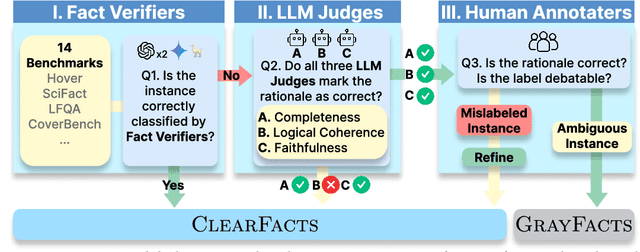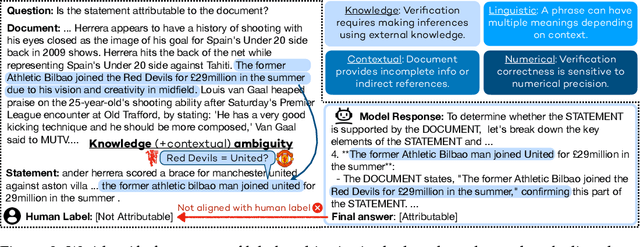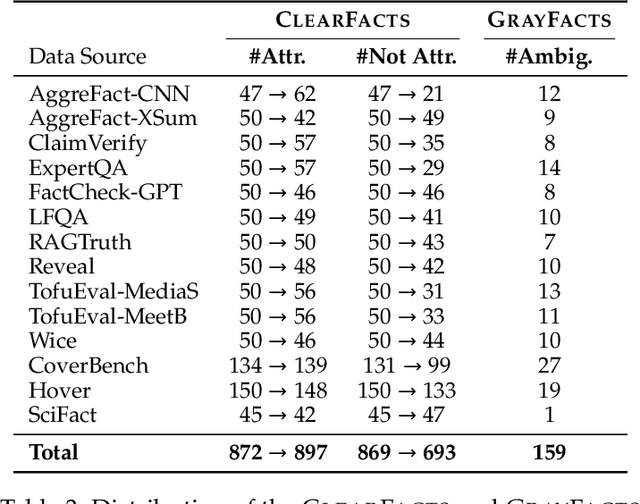Jaehun Jung
Long Grounded Thoughts: Distilling Compositional Visual Reasoning Chains at Scale
Nov 07, 2025Abstract:Recent progress in multimodal reasoning has been driven largely by undisclosed datasets and proprietary data synthesis recipes, leaving open questions about how to systematically build large-scale, vision-centric reasoning datasets, particularly for tasks that go beyond visual math. In this work, we introduce a new reasoning data generation framework spanning diverse skills and levels of complexity with over 1M high-quality synthetic vision-centric questions. The dataset also includes preference data and instruction prompts supporting both offline and online RL. Our synthesis framework proceeds in two stages: (1) scale; and (2) complexity. Reasoning traces are then synthesized through a two-stage process that leverages VLMs and reasoning LLMs, producing CoT traces for VLMs that capture the richness and diverse cognitive behaviors found in frontier reasoning models. Remarkably, we show that finetuning Qwen2.5-VL-7B on our data outperforms all open-data baselines across all evaluated vision-centric benchmarks, and even surpasses strong closed-data models such as MiMo-VL-7B-RL on V* Bench, CV-Bench and MMStar-V. Perhaps most surprising, despite being entirely vision-centric, our data transfers positively to text-only reasoning (MMLU-Pro) and audio reasoning (MMAU), demonstrating its effectiveness. Similarly, despite not containing videos or embodied visual data, we observe notable gains when evaluating on a single-evidence embodied QA benchmark (NiEH). Finally, we use our data to analyze the entire VLM post-training pipeline. Our empirical analysis highlights that (i) SFT on high-quality data with non-linear reasoning traces is essential for effective online RL, (ii) staged offline RL matches online RL's performance while reducing compute demands, and (iii) careful SFT on high quality data can substantially improve out-of-domain, cross-modality transfer.
ProfBench: Multi-Domain Rubrics requiring Professional Knowledge to Answer and Judge
Oct 21, 2025



Abstract:Evaluating progress in large language models (LLMs) is often constrained by the challenge of verifying responses, limiting assessments to tasks like mathematics, programming, and short-form question-answering. However, many real-world applications require evaluating LLMs in processing professional documents, synthesizing information, and generating comprehensive reports in response to user queries. We introduce ProfBench: a set of over 7000 response-criterion pairs as evaluated by human-experts with professional knowledge across Physics PhD, Chemistry PhD, Finance MBA and Consulting MBA. We build robust and affordable LLM-Judges to evaluate ProfBench rubrics, by mitigating self-enhancement bias and reducing the cost of evaluation by 2-3 orders of magnitude, to make it fair and accessible to the broader community. Our findings reveal that ProfBench poses significant challenges even for state-of-the-art LLMs, with top-performing models like GPT-5-high achieving only 65.9\% overall performance. Furthermore, we identify notable performance disparities between proprietary and open-weight models and provide insights into the role that extended thinking plays in addressing complex, professional-domain tasks. Data: https://huggingface.co/datasets/nvidia/ProfBench and Code: https://github.com/NVlabs/ProfBench
NVIDIA Nemotron Nano 2: An Accurate and Efficient Hybrid Mamba-Transformer Reasoning Model
Aug 21, 2025



Abstract:We introduce Nemotron-Nano-9B-v2, a hybrid Mamba-Transformer language model designed to increase throughput for reasoning workloads while achieving state-of-the-art accuracy compared to similarly-sized models. Nemotron-Nano-9B-v2 builds on the Nemotron-H architecture, in which the majority of the self-attention layers in the common Transformer architecture are replaced with Mamba-2 layers, to achieve improved inference speed when generating the long thinking traces needed for reasoning. We create Nemotron-Nano-9B-v2 by first pre-training a 12-billion-parameter model (Nemotron-Nano-12B-v2-Base) on 20 trillion tokens using an FP8 training recipe. After aligning Nemotron-Nano-12B-v2-Base, we employ the Minitron strategy to compress and distill the model with the goal of enabling inference on up to 128k tokens on a single NVIDIA A10G GPU (22GiB of memory, bfloat16 precision). Compared to existing similarly-sized models (e.g., Qwen3-8B), we show that Nemotron-Nano-9B-v2 achieves on-par or better accuracy on reasoning benchmarks while achieving up to 6x higher inference throughput in reasoning settings like 8k input and 16k output tokens. We are releasing Nemotron-Nano-9B-v2, Nemotron-Nano12B-v2-Base, and Nemotron-Nano-9B-v2-Base checkpoints along with the majority of our pre- and post-training datasets on Hugging Face.
Verifying the Verifiers: Unveiling Pitfalls and Potentials in Fact Verifiers
Jun 16, 2025



Abstract:Fact verification is essential for ensuring the reliability of LLM applications. In this study, we evaluate 12 pre-trained LLMs and one specialized fact-verifier, including frontier LLMs and open-weight reasoning LLMs, using a collection of examples from 14 fact-checking benchmarks. We share three findings intended to guide future development of more robust fact verifiers. First, we highlight the importance of addressing annotation errors and ambiguity in datasets, demonstrating that approximately 16\% of ambiguous or incorrectly labeled data substantially influences model rankings. Neglecting this issue may result in misleading conclusions during comparative evaluations, and we suggest using a systematic pipeline utilizing LLM-as-a-judge to help identify these issues at scale. Second, we discover that frontier LLMs with few-shot in-context examples, often overlooked in previous works, achieve top-tier performance. We therefore recommend future studies include comparisons with these simple yet highly effective baselines. Lastly, despite their effectiveness, frontier LLMs incur substantial costs, motivating the development of small, fine-tuned fact verifiers. We show that these small models still have room for improvement, particularly on instances that require complex reasoning. Encouragingly, we demonstrate that augmenting training with synthetic multi-hop reasoning data significantly enhances their capabilities in such instances. We release our code, model, and dataset at https://github.com/just1nseo/verifying-the-verifiers
Socratic-MCTS: Test-Time Visual Reasoning by Asking the Right Questions
Jun 10, 2025Abstract:Recent research in vision-language models (VLMs) has centered around the possibility of equipping them with implicit long-form chain-of-thought reasoning -- akin to the success observed in language models -- via distillation and reinforcement learning. But what about the non-reasoning models already trained and deployed across the internet? Should we simply abandon them, or is there hope for a search mechanism that can elicit hidden knowledge and induce long reasoning traces -- without any additional training or supervision? In this paper, we explore this possibility using a Monte Carlo Tree Search (MCTS)-inspired algorithm, which injects subquestion-subanswer pairs into the model's output stream. We show that framing reasoning as a search process -- where subquestions act as latent decisions within a broader inference trajectory -- helps the model "connect the dots" between fragmented knowledge and produce extended reasoning traces in non-reasoning models. We evaluate our method across three benchmarks and observe consistent improvements. Notably, our approach yields a 2% overall improvement on MMMU-PRO, including a significant 9% gain in Liberal Arts.
Prismatic Synthesis: Gradient-based Data Diversification Boosts Generalization in LLM Reasoning
May 26, 2025Abstract:Effective generalization in language models depends critically on the diversity of their training data. Yet existing diversity metrics often fall short of this goal, relying on surface-level heuristics that are decoupled from model behavior. This motivates us to ask: What kind of diversity in training data actually drives generalization in language models -- and how can we measure and amplify it? Through large-scale empirical analyses spanning over 300 training runs, carefully controlled for data scale and quality, we show that data diversity can be a strong predictor of generalization in LLM reasoning -- as measured by average model performance on unseen out-of-distribution benchmarks. We introduce G-Vendi, a metric that quantifies diversity via the entropy of model-induced gradients. Despite using a small off-the-shelf proxy model for gradients, G-Vendi consistently outperforms alternative measures, achieving strong correlation (Spearman's $\rho \approx 0.9$) with out-of-distribution (OOD) performance on both natural language inference (NLI) and math reasoning tasks. Building on this insight, we present Prismatic Synthesis, a framework for generating diverse synthetic data by targeting underrepresented regions in gradient space. Experimental results show that Prismatic Synthesis consistently improves model performance as we scale synthetic data -- not just on in-distribution test but across unseen, out-of-distribution benchmarks -- significantly outperforming state-of-the-art models that rely on 20 times larger data generator than ours. For example, PrismMath-7B, our model distilled from a 32B LLM, outperforms R1-Distill-Qwen-7B -- the same base model trained on proprietary data generated by 671B R1 -- on 6 out of 7 challenging benchmarks.
Retro-Search: Exploring Untaken Paths for Deeper and Efficient Reasoning
Apr 06, 2025



Abstract:Large reasoning models exhibit remarkable reasoning capabilities via long, elaborate reasoning trajectories. Supervised fine-tuning on such reasoning traces, also known as distillation, can be a cost-effective way to boost reasoning capabilities of student models. However, empirical observations reveal that these reasoning trajectories are often suboptimal, switching excessively between different lines of thought, resulting in under-thinking, over-thinking, and even degenerate responses. We introduce Retro-Search, an MCTS-inspired search algorithm, for distilling higher quality reasoning paths from large reasoning models. Retro-Search retrospectively revises reasoning paths to discover better, yet shorter traces, which can then lead to student models with enhanced reasoning capabilities with shorter, thus faster inference. Our approach can enable two use cases: self-improvement, where models are fine-tuned on their own Retro-Search-ed thought traces, and weak-to-strong improvement, where a weaker model revises stronger model's thought traces via Retro-Search. For self-improving, R1-distill-7B, fine-tuned on its own Retro-Search-ed traces, reduces the average reasoning length by 31.2% while improving performance by 7.7% across seven math benchmarks. For weak-to-strong improvement, we retrospectively revise R1-671B's traces from the OpenThoughts dataset using R1-distill-32B as the Retro-Search-er, a model 20x smaller. Qwen2.5-32B, fine-tuned on this refined data, achieves performance comparable to R1-distill-32B, yielding an 11.3% reduction in reasoning length and a 2.4% performance improvement compared to fine-tuning on the original OpenThoughts data. Our work counters recently emergent viewpoints that question the relevance of search algorithms in the era of large reasoning models, by demonstrating that there are still opportunities for algorithmic advancements, even for frontier models.
Trust or Escalate: LLM Judges with Provable Guarantees for Human Agreement
Jul 25, 2024



Abstract:We present a principled approach to provide LLM-based evaluation with a rigorous guarantee of human agreement. We first propose that a reliable evaluation method should not uncritically rely on model preferences for pairwise evaluation, but rather assess the confidence of judge models and selectively decide when to trust its judgement. We then show that under this selective evaluation framework, human agreement can be provably guaranteed -- such that the model evaluation aligns with that of humans to a user-specified agreement level. As part of our framework, we also introduce Simulated Annotators, a novel confidence estimation method that significantly improves judge calibration and thus enables high coverage of evaluated instances. Finally, we propose Cascaded Selective Evaluation, where we use cheaper models as initial judges and escalate to stronger models only when necessary -- again, while still providing a provable guarantee of human agreement. Experimental results show that Cascaded Selective Evaluation guarantees strong alignment with humans, far beyond what LLM judges could achieve without selective evaluation. For example, on a subset of Chatbot Arena where GPT-4 almost never achieves 80% human agreement, our method, even while employing substantially cost-effective models such as Mistral-7B, guarantees over 80% human agreement with almost 80% test coverage.
Information-Theoretic Distillation for Reference-less Summarization
Mar 20, 2024Abstract:The current winning recipe for automatic summarization is using proprietary large-scale language models (LLMs) such as ChatGPT as is, or imitation learning from them as teacher models. While increasingly ubiquitous dependence on such large-scale language models is convenient, there remains an important question of whether small-scale models could have achieved competitive results, if we were to seek an alternative learning method -- that allows for a more cost-efficient, controllable, yet powerful summarizer. We present InfoSumm, a novel framework to distill a powerful summarizer based on the information-theoretic objective for summarization, without relying on either the LLM's capability or human-written references. To achieve this, we first propose a novel formulation of the desiderata of summarization (saliency, faithfulness and brevity) through the lens of mutual information between the original document and the summary. Based on this formulation, we start off from Pythia-2.8B as the teacher model, which is not yet capable of summarization, then self-train the model to optimize for the information-centric measures of ideal summaries. Distilling from the improved teacher, we arrive at a compact but powerful summarizer with only 568M parameters that performs competitively against ChatGPT, without ever relying on ChatGPT's capabilities. Extensive analysis demonstrates that our approach outperforms in-domain supervised models in human evaluation, let alone state-of-the-art unsupervised methods, and wins over ChatGPT in controllable summarization.
JAMDEC: Unsupervised Authorship Obfuscation using Constrained Decoding over Small Language Models
Feb 13, 2024



Abstract:The permanence of online content combined with the enhanced authorship identification techniques calls for stronger computational methods to protect the identity and privacy of online authorship when needed, e.g., blind reviews for scientific papers, anonymous online reviews, or anonymous interactions in the mental health forums. In this paper, we propose an unsupervised inference-time approach to authorship obfuscation to address the unique challenges of authorship obfuscation: lack of supervision data for diverse authorship and domains, and the need for a sufficient level of revision beyond simple paraphrasing to obfuscate the authorship, all the while preserving the original content and fluency. We introduce JAMDEC, a user-controlled, inference-time algorithm for authorship obfuscation that can be in principle applied to any text and authorship. Our approach builds on small language models such as GPT2-XL in order to help avoid disclosing the original content to proprietary LLM's APIs, while also reducing the performance gap between small and large language models via algorithmic enhancement. The key idea behind our approach is to boost the creative power of smaller language models through constrained decoding, while also allowing for user-specified controls and flexibility. Experimental results demonstrate that our approach based on GPT2-XL outperforms previous state-of-the-art methods based on comparably small models, while performing competitively against GPT3.5 175B, a propriety model that is two orders of magnitudes larger.
 Add to Chrome
Add to Chrome Add to Firefox
Add to Firefox Add to Edge
Add to Edge